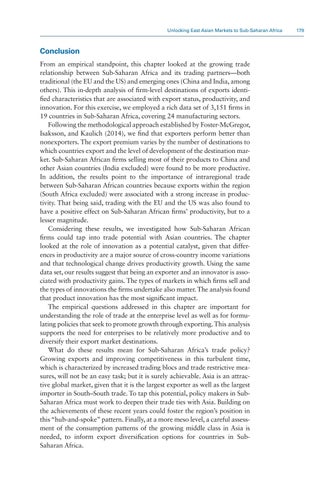Unlocking East Asian Markets to Sub-Saharan Africa 179
Conclusion From an empirical standpoint, this chapter looked at the growing trade relationship between Sub-Saharan Africa and its trading partners—both traditional (the EU and the US) and emerging ones (China and India, among others). This in-depth analysis of firm-level destinations of exports identified characteristics that are associated with export status, productivity, and innovation. For this exercise, we employed a rich data set of 3,151 firms in 19 countries in Sub-Saharan Africa, covering 24 manufacturing sectors. Following the methodological approach established by Foster-McGregor, Isaksson, and Kaulich (2014), we find that exporters perform better than nonexporters. The export premium varies by the number of destinations to which countries export and the level of development of the destination market. Sub-Saharan African firms selling most of their products to China and other Asian countries (India excluded) were found to be more productive. In addition, the results point to the importance of intraregional trade between Sub-Saharan African countries because exports within the region (South Africa excluded) were associated with a strong increase in productivity. That being said, trading with the EU and the US was also found to have a positive effect on Sub-Saharan African firms’ productivity, but to a lesser magnitude. Considering these results, we investigated how Sub-Saharan African firms could tap into trade potential with Asian countries. The chapter looked at the role of innovation as a potential catalyst, given that differences in productivity are a major source of cross-country income variations and that technological change drives productivity growth. Using the same data set, our results suggest that being an exporter and an innovator is associated with productivity gains. The types of markets in which firms sell and the types of innovations the firms undertake also matter. The analysis found that product innovation has the most significant impact. The empirical questions addressed in this chapter are important for understanding the role of trade at the enterprise level as well as for formulating policies that seek to promote growth through exporting. This analysis supports the need for enterprises to be relatively more productive and to diversify their export market destinations. What do these results mean for Sub-Saharan Africa’s trade policy? Growing exports and improving competitiveness in this turbulent time, which is characterized by increased trading blocs and trade restrictive measures, will not be an easy task; but it is surely achievable. Asia is an attractive global market, given that it is the largest exporter as well as the largest importer in South–South trade. To tap this potential, policy makers in SubSaharan Africa must work to deepen their trade ties with Asia. Building on the achievements of these recent years could foster the region’s position in this “hub-and-spoke” pattern. Finally, at a more meso level, a careful assessment of the consumption patterns of the growing middle class in Asia is needed, to inform export diversification options for countries in SubSaharan Africa.


